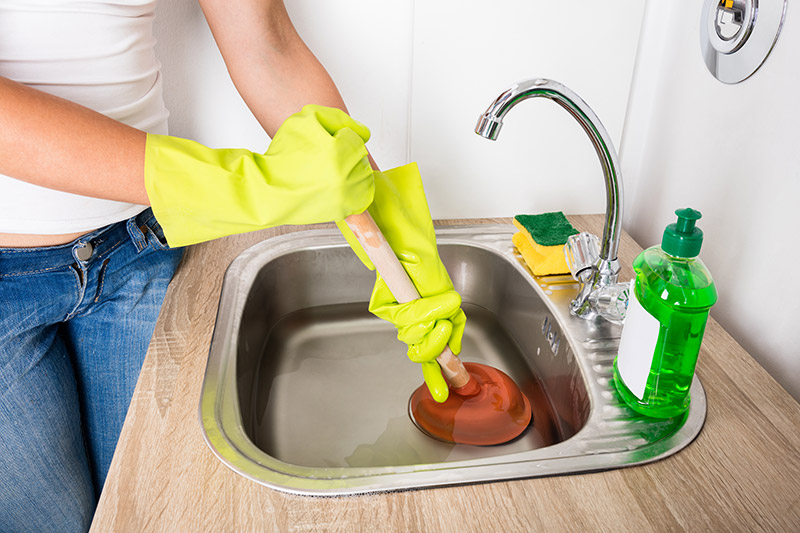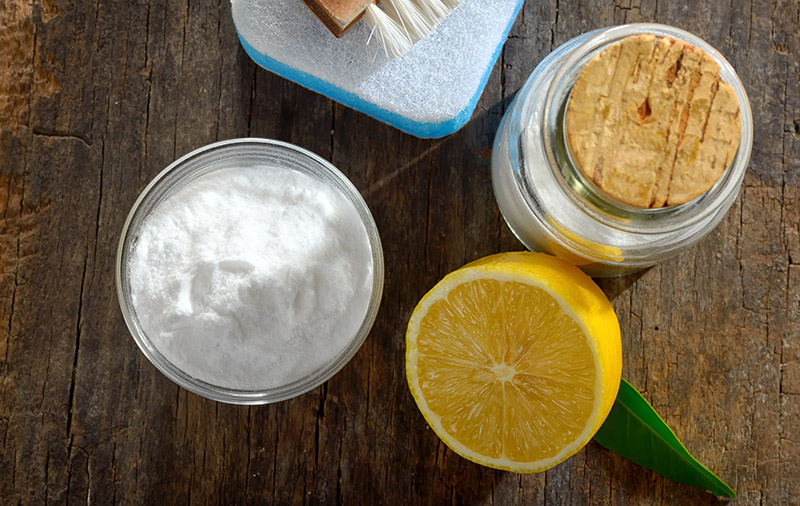Septic Safe Drain Cleaner: Best Options for Unclogging
This page may contain affiliate links. If you make a purchase through one of our affiliate links, we’ll earn a commission, at no extra cost to you. For more details, please read our disclosure.

If you have a septic tank, you must be careful about the products you use to clean your drains. Some conventional drain cleaners are unsafe for septic systems and can lead to costly repairs or even system failure.
The bacteria in septic tanks are essential for breaking down waste and allowing the system to function properly. Some cleaning products include harsh chemicals like bleach that can kill the bacteria in a septic tank, which may cause long-term problems. The tank may need to be emptied more frequently, or you may experiences issues with it not draining as it should. This may lead to backups or unwanted plumbing issues in the house.
Thankfully, there are many options currently available for septic-safe cleaning products, including DIY options as well as products that can be purchased. Here we will look at septic-safe drain cleaner specifically.
Are Liquid Drain Cleaners Septic-Safe Drain Cleaners?
The answer to this question is both yes and no. It depends on the ingredients in the cleaner and how you use it. Some liquid drain cleaners are safe for septic tanks as long as they’re used sparingly and according to the manufacturer’s instructions. However, some natural alternatives are just as effective and won’t harm your septic system.
Two of the most popular drain cleaning products are Drano and Liquid Plumr. Both manufacturers state that the products are safe for septic tanks. However, not everyone agrees that these liquid cleaners will not cause long-term harm to a septic tank. Additionally, many homeowners, especially parents with young children, prefer to avoid cleaning products that include harsh chemicals for the safety of everyone in the house.
We recommend using natural cleaning products whenever possible, especially if you live in a house with a septic tank. Thankfully, there are a few natural and DIY options, and we’ll cover the details below.
Use a Plunger
The first step you should take when your drain is clogged (or if you have a slow drain) is to use a plunger. Plungers are relatively inexpensive (you probably already have at least one in your house) and can be used on most drains, including toilets, sinks, and bathtubs.
For best results, ensure the plunger you’re using is appropriate for the size and shape of the drain. Fill the sink or tub with enough water to cover the bell of the plunger. This will create a seal so the plunger can work effectively.
Place the plunger over the drain and vigorously push and pull it up.
You may need to repeat this process a few times before the clog loosens. Once it does, you should be able to flush the drain with hot water to remove any remaining debris.
Do not use a plunger if you also use a liquid cleaner, as it can splash upon you.
If the plunger doesn’t work, you can try a drain snake if you have one.
Unclogging Drains with Hot Water
One of the easiest ways to unclog a drain is using hot water. This won’t work on major clogs, but it is generally effective for smaller, simple clogs.
The heat can help break down any grease or soap scum causing the drain clog. To do this, simply boil a pot of water and pour it down the drain. Be careful not to splash the hot water on yourself.
It’s important to note that boiling water can soften or damage PVC pipes, so it’s best to use this method sparingly to avoid causing any damage.
Homemade Drain Cleaner

There are a few DIY septic-safe drain cleaners you can make with simple ingredients that you probably already have in your house. Best of all, these solutions are safe for your septic tank and your family.
Baking Soda and Vinegar
 Harris Cleaning Vinegar, Orange
Harris Cleaning Vinegar, Orange
One of the most popular DIY drain cleaners is a mixture of baking soda and vinegar. The two ingredients create a chemical reaction that can help break down the clog.
To use this method, pour 1/2 cup of baking soda down the drain, followed by 1/2 cup vinegar. Cover the drain with a plug or cloth to keep the mixture in, and let it sit for about 30 minutes.
After 30 minutes, remove the plug or cloth and flush the drain by pouring in a pot of hot water.
Baking Soda and Lemon Juice
Another effective septic-safe drain cleaner is a mixture of baking soda and lemon juice. The acidity in the lemon juice can help break down the clog, while the baking soda will work to clean the drain without damaging the septic system.
To use this method, mix 1/2 cup of baking soda with 1/4 cup of lemon juice. Pour the mixture down the drain and let it sit for about 30 minutes.
After 30 minutes, flush the drain with a pot of hot water. You may need to repeat this process a few times for tough clogs.
Baking Soda and Salt
Baking soda and salt can help break down a clog. The salt will work to absorb any moisture in the clog, while the baking soda will help to break it down.
To use this method as a natural drain opener, mix 1/2 cup of baking soda with 1/4 cup of salt. Pour the mixture down the drain and let it sit for about 30 minutes.
After 30 minutes, flush the drain with running hot water. Again, you may need to repeat this process several times for tough clogs.
Related: How to Wash Fruit and Vegetables
Natural Drain Cleaner
If you’re not interested in the DIY methods, you could try a septic-safe drain cleaner made with natural ingredients. Biokleen Bac-Out Drain Cleaner is an enzymatic formula made with plant extracts.
 Biokleen Bac-Out Drain Cleaner
Biokleen Bac-Out Drain Cleaner
It’s an eco-friendly product that does not contain ingredients like ammonia, chlorine, or phosphates, which may be harmful to septic tanks. It’s biodegradable and is never tested on animals. Overall, we believe it’s the best drain cleaner.
Preventing Clogged Drains
The best way to deal with a clogged drain is to prevent it from happening in the first place. You can do a few things to help keep your drains clear and free of clogs.
Invest in a Drain Strainer
 Durable Silicone Hair Stopper Shower Drain Covers
Durable Silicone Hair Stopper Shower Drain Covers
A drain strainer is a small mesh screen that you can place over your drain to catch hair, soap scum, and other debris before it can go down the drain. This is an especially good idea if you have long hair or live in an area with hard water.
Clean Your Drains Regularly
It’s important to clean your drains regularly to prevent them from becoming clogged. You can use a natural cleaner like Biokleen Bac-Out Drain Cleaner, or you can make your own with baking soda and vinegar.
Be Careful What You Put Down the Drain
One of the main causes of clogged drains is grease, hair, and other debris that gets washed down the drain. Be careful what you put down your drain, and try to avoid letting hair or grease go down the drain pipe.
Related: How to Clear a Clogged Drain the Natural Way
Frequently Asked Questions
What drain cleaner is safe for septic systems?
There are a few natural drain cleaners that are safe for septic systems. Baking soda and vinegar is one option. Another is to mix baking soda with lemon juice or salt. You could also try a commercial product like Biokleen Bac-Out Drain Cleaner instead of harsh chemical cleaners
Is Drano septic safe?
The manufacturers of Drano state that the cleaning product is safe for septic tanks. However, we recommend natural products instead. Since there are natural options that do not involve harsh chemicals, we recommend using one of those other options to be cautious.
Is Liquid Plumr septic safe?
The manufacturers of Liquid Plumr state that the product is safe for septic tanks. However, we recommend natural products instead. Since there are natural options that do not involve harsh chemicals, we recommend using one of those other options to be cautious.
What can I use instead of drain cleaner?
There are a few options you can use instead of chemical drain cleaner. Baking soda and vinegar are options. Another is to mix baking soda with lemon juice or salt. These homemade drain cleaners are generally effective when dealing with small or moderate clogs. You may need professional assistance to remove a major clog.
Does vinegar clean drains?
Vinegar can help to clean drains and prevent clogs. The acidity of vinegar helps to break down grease, hair, and other debris. Vinegar is also effective at removing mineral deposits that can build up in your pipes.
Will vinegar hurt PVC pipes?
No, moderate amounts of vinegar will not hurt PVC pipes. It can actually be effective at removing mineral deposits that can build up on the inside of your pipes.
Final Thoughts on Septic Safe Drain Cleaner
If you’re looking for a septic-safe drain cleaner, there are a few options available. You can use a natural cleaner like vinegar or baking soda. You could also try a commercial product like Biokleen Bac-Out Drain Cleaner.
Preventing clogged drains is the best way to deal with them and protect your septic system. You can do this by investing in a drain strainer and cleaning your drains regularly. Be careful what you put down your drain, and avoid letting hair or grease go down the drain. If you have any questions or concerns, be sure to speak with a plumbing professional.



